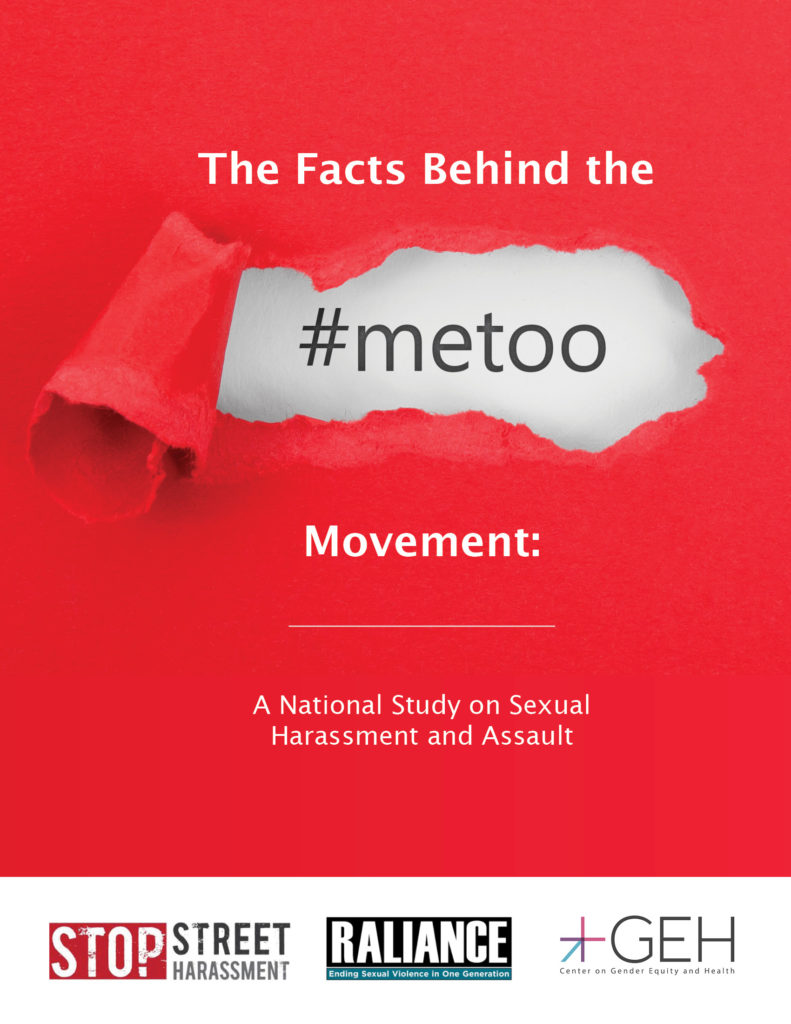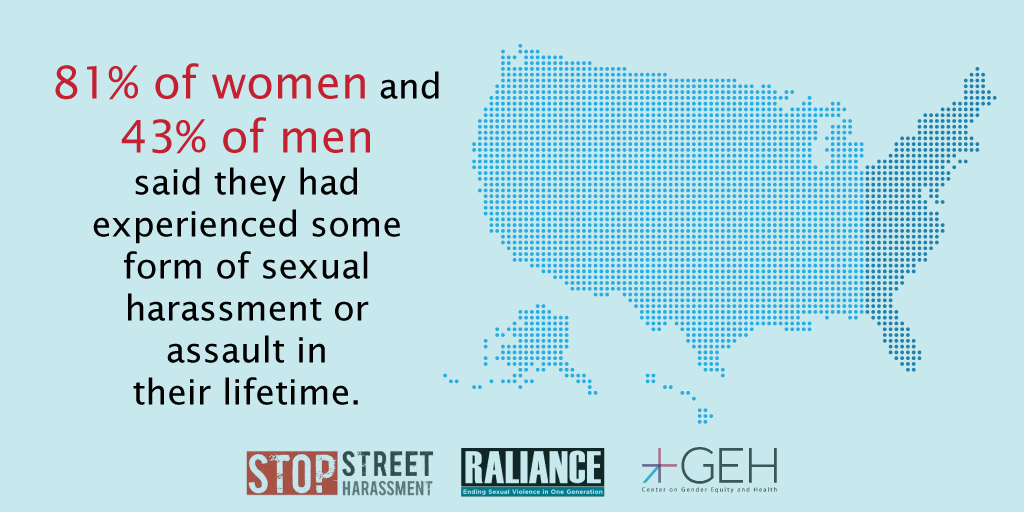 February 21, 2018: In January 2018, SSH commissioned a 2,000-person, nationally representative survey on sexual harassment and assault, conducted by GfK. It found that nationwide, 81% of women and 43% of men reported experiencing some form of sexual harassment and/or assault in their lifetime.
February 21, 2018: In January 2018, SSH commissioned a 2,000-person, nationally representative survey on sexual harassment and assault, conducted by GfK. It found that nationwide, 81% of women and 43% of men reported experiencing some form of sexual harassment and/or assault in their lifetime.


While verbal sexual harassment was the most common form (77% of women and 34% of men), an alarming 51% of women and 17% of men said they were touched or groped in an unwelcome way, and 27% of women and 7% of men survived sexual assault.
Pro bono data analysis for the survey was completed by the UC San Diego Center on Gender Equity and Health. Their team, the team at Raliance and a dozen advisory committee members offered input and invaluable help throughout the process.
READ: Full Report | Two-Page Executive Summary | Survey Questions | Methodology |
Press Release | Bystander Intervention Tip Sheet | Youth Fact Sheet
MEDIA:
Contact SSH at StopStreetHarassment@Gmail.com for interview requests
New York Times, “Numbers Hint at Why #MeToo Took Off: The Sheer Number Who Can Say Me Too.” (It was linked to in the NYT Daily Briefing on 2/22/18)
NPR, “A New Survey Finds 81 Percent Of Women Have Experienced Sexual Harassment.” It was picked up by NPR Illinois, Minnesota Public Radio, WHYY, and WVPE.
VOX News, “Measuring #MeToo: more than 80 percent of women have been sexually harassed or assaulted.“
Newsweek, “#MeToo Study Finds Nearly All Women and Almost Half of Men in U.S. Have Faced Sexual Harassment or Assault.”
Los Angeles Times, “International Women’s Day by the Numbers.”
Ms. Magazine Blog, “What the Numbers Behind the #MeToo Movement Show Us.“
VOX News, “‘I was blaming myself and I was miserable’: Brendan Fraser’s #MeToo moment.”
Buzzfeed, “”Why Didn’t You Fight Back?” And Other Questions That Keep Male Sexual Harassment Victims Silent.”
Teen Vogue, “#MeToo Study Shows Sexual Harassment and Assault Scope.”
Huffington Post, “People with Disabilities Have Been Left Out of Conversations about Harassment.”
Independent, “Morgan Freeman has been accused of Sexual Harassment – So What Else is New?“
New York Minute Magazine, “Street Harassment: When It’s Not ‘Just a Joke’.”
Glamour, “What to do when someone you know has been accused of sexual harassment.”
Refinery 29, “The Three Places Where Sexual Harassment is Most Common.”
The Voice of San Diego, “The #MeToo Movement Is More Widespread Than You Thought.”
Market Watch, “Young single Americans are tired, confused and scared about dating during #Metoo.”
Refinery 29, “What To Do When You Witness Sexual Harassment.”
News Tribune, “Illinois Valley Community College says #MeToo.”
The Collegian: Saint Mary’s College of California,”Letter to the Editor: a response to #MeToo and Time’s Up article.”
Romper, “How Many Americans Think #MeToo Claims Are False? A Distressing Amount, According To A New Survey.”
Bustle, “Most Republicans Think #MeToo Has Created A Real Burden For Men At Work.”
Register, “Sexual Harassment at BHS.”
WHY:
In October 2017, numerous women in Hollywood came forward with sexual abuse allegations against Harvey Weinstein, an incredibly influential film producer with the power to make or break careers. While stories about sexual abuse are not new, the climate of the country was such that the stories about Weinstein and the individuals and institutions complicit with his abusive behaviors hit a nerve.
Long before this national moment, Tarana Burke created a “Me Too” movement in 2007 to help victims of sexual harassment and assault. Initially inadvertently building on Burke’s work, on October 15, 2017, actress Alyssa Milano invited people to use a #MeToo hashtag to show just how widespread sexual harassment and assault are in the United States beyond Weinstein and the stories in the headlines. Soon, millions of people had used the hashtag. Within a few days, Facebook reported that 45% of users in the US had at least one friend who had posted #MeToo on their timeline.
Now, four months later, dozens of high-profile men have been fired or resigned from their jobs in the entertainment, arts, political, sports, and business industries because of women and some men who came forward with their allegations of abuse. In many cases the accounts of abuse were confirmed by multiple victims sharing similar stories about the same perpetrator, showing a clear pattern of abuse and predatory behavior, which was all too often ignored by individuals and institutions who failed to hold these perpetrators accountable.
Many of the #MeToo headlines and media stories have focused on wealthy and/or white women’s experiences, specifically in the workplace. Part of the reason for this oversight is the lack of recent data documenting the entirety of the problem.
Initially in October 2017, SSH received inquiries from journalists asking if there was a study that tracked a single statistic on the full scope of sexual abuses women face, including sexual harassment and assault, across locations like workplaces and public spaces. As it turned out, existing research was segmented (such as SSH’s 2014 national study on sexual harassment in public spaces or AAUW’s 2011 national study on sexual harassment in grades 7-12) and often dated. Further, while the Centers for Disease Control and Prevention (CDC) has a comprehensive study, National Intimate Partner and Sexual Violence Survey (NISVS) that encompasses many of the behaviors tracked in this study, it focuses more heavily on physical forms and does not distinguish respondents’ experiences by locations like public spaces, workplaces, schools and homes.
So, when asked for one, comprehensive figure across locations, the answer was complicated and not easily ascertainable. They also wanted to see where these abuses most often occur and who demographically was at greater risk and while the CDC NISVS has demographic information for sexual violence, it again was not available across the locations where such violence typically occurs. Nor does it break down who perpetrators are in relation to the people they harm. Now, thanks to the help of our partners, donors and advisory committee, we have that information.
This report contains the facts and figures behind the #MeToo movement and the stories so many people have shared. But the findings go beyond #MeToo.
The findings demonstrate that this is not just an issue that affects women; it affects any group that is marginalized. The findings show that sexual harassment and assault are abuses of power, disrespect, and disregard for human dignity. And, long after #MeToo fades away, these findings will remain to show how far we must go to ensure that everyone who lives in the United States feels free and safe from sexual abuse, from the time they are born until the time they die.
TOPICS:
The report covers information on these five main topics:
- The prevalence and most frequently experienced types of sexual harassment and assault overall.
- The locations where sexual harassment and assault take place.
- When sexual harassment and assault occurs, from people’s first experience to their most recent.
- The perpetrators of sexual harassment and assault.
- How sexual harassment and assault makes people feel and what they do because of it.
Demographic information is broken down by gender, race/ethnicity, sexual orientation, household income, disability, age, and region of the country for each section, when the sample size allowed.
DONORS:
Organizations
Center on Gender Equity and Health, University of California, San Diego
Feminist Public Works
PinPoint Foundation
Raliance
Individuals
Vincente Abril
Sumit A Bafna
Robin B Bedilion
Suzanne Biggs
Andre M. Bravo
Katherine Broendel & Sean Crosbie
Stephane Budel
Sylvie Burns
Shintien Cheng
Richard Chew
Pamela Collins
Suzanne DeFelice
Jesse Drew
Jennifer Epstein
Maureen Evans Arthurs
Kate Farrar
Jackie W Fischbeck
Michelle Hamilton
Emily Harris
Angela Hattery
Heather-Nicole Hoffman
Christy Jones
Alan Kearl & Beckie Weinheimer
Holly Kearl & Mark Hutchens
Mary L W Kearl & Roberto Orellana
Michael Kipp
Michelle Kunz
Rebecca Lanning
Sally Laskey
Melissa Lewis
Bijou Lucas
Helen E. Luryi
Alice Lynn
Carl Manlan
Lucinda Marshall
Kristina Martino
Patrick McNeil
Kathleen Milligan
Layla Moughari
Arvid Muller
Astrid Muller
Sarah Murphy
Esther Ngumbi
Andrea Pino
Britnae Purdy
Oraia Reid
Emily Resnick
Adrian Richwell
Linda Saccoccio
Isabel Dewey Seavey
Michelle Sesco
Donna Seymour
Dinitia Smith
Daljit & Anuj Soni
Joanne N. Smith
Julia Strange
Kate Sweeney
Lauren Taylor
Nancy Unger
Elizabeth Vandenburg
Kerry Weinheimer
